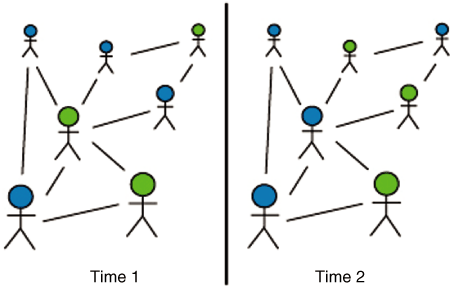Social Networks Do Not Explain Physical Activity Levels and Obesity in Younger Adults
 Previous studies have suggested that obesity is ‘transmitted’ in social networks.
Previous studies have suggested that obesity is ‘transmitted’ in social networks.
A study by Janette Leroux (Canadian Obesity Network Bootcamper, class of 2012) and colleagues from the Queen’s University, Kingston, ON, published in PLoS One, now explores the relationships between ‘perceived’ physical activity, obesity, and social networks in about 2,000 participants in the Montreal Neighborhood Networks and Healthy Aging study.
In younger adults (<55 years old), although physical inactivity increased the odds of obesity and of having a higher number of perceived exercising close ties (alters), physical activity did not appear to mediate the association between obesity and the exercising behavior of alters.
Among adults older than 55 years, physical inactivity likewise increased the odds of being obese while having a higher number of exercising alters slightly reduced an older adult’s chances of being obese. However, in contrast to the younger adults, in this older population, a small part of this physical inactivity did appear to be ‘mediated’ by the association between exercising alters and obesity.
Based on these findings, the authors suggest that at least for older adults, social networks may be important determinants of physical inactivity, a finding that may suggest the usefulness of community interventions to promote physical activity and reduce obesity in this population.
However, the authors are also careful to point out that, given the cross-sectional nature of this study, one should not make inferences about causality. Thus, the study cannot answer the question, whether or not active people simply tend to hang out with other active people or whether active people actually ‘transfer’ their higher activity levels to their inactive friends? Nor does it answer the question, whether hanging out with inactive people slows down folks who would otherwise be active – after all, this relationship, if it indeed exists, could well work in either direction.
The authors also note that because of the self-reported nature of activity levels, this study has more to do with ‘perceived’ rather than actual activity levels (hence the title of the paper). After all, it may well be that skinny folks are over-reporting their activity levels, whereas, obese individuals are perhaps underestimating the amount of work it actually takes to move their larger bodies around.
The implications of the association between inactivity and obesity are also unclear – after all, is it (perceived) inactivity that leads to obesity or does obesity lead to (perceived) inactivity?
Thus, it may be fair to conclude from this study that social networks are unlikely to account for any relationship between physical activity (or inactivity) and obesity levels in younger adults and that in older adults, although such relationships may exist, causality remains to be determined.
My take away from this study, is that the relationship between physical activity (or inactivity) and obesity, whether in social networks or otherwise, remains far more complex and less straightforward, than many of us would like to think.
This is not to say that increasing physical activity and reducing inactivity does not have its health benefits. But questions certainly remain whether a) social networks can indeed be harnessed to promote physical activity and b) an increase in activity (or reduction in inactivity) would in fact translate into lower obesity rates.
Perhaps, none of this matters, as greater physical activity and less sedentariness can certainly promote health at any size.
AMS
Edmonton, Alberta
photo credit: jenny downing via photopin cc
Obesity May Cost US Boomer Babies $1 Trillion in Lifetime Earnings
 Born between 1982 and 1993, the kids of the Baby Boomers are sometimes also referred to as the Millennial generation, Generation Y, Net Generation, or Echo-Boomers.
Born between 1982 and 1993, the kids of the Baby Boomers are sometimes also referred to as the Millennial generation, Generation Y, Net Generation, or Echo-Boomers.
This generation has fully embraced social networking (e.g. Facebook) and file sharing (e.g. Napster) and spends an average of 3.5 hours a day online. They have also been noted to live longer with and be more dependent on their parents while at the same time valuing flexibility and independence.
Importantly perhaps, up to one in three members of this generation in one third of the US States is now clinically obese.
As this generation enters the workforce, how will the obesity epidemic impact their economic health and expected earnings?
It may be reasonable to ask this question, as obesity will likely negatively impact their productivity and, as a result, their economic prosperity. Not only do obese individuals tend to miss more days at work but especially obese women have been shown to earn substantially lower wages (around 12% less) than their normal-weight counterparts.
This question of lifetime earning was now addressed by Shari Barkin and colleagues from Vanderbilt University, Nashville, TN, in a paper just published in the Journal of Business Psychology.
Utilizing evidence in the existing literature, the researchers created an economic model to predict the impact of obesity on the aggregate lifetime earnings for the Millennial generation and the consequences for employers and employees.
If the assumptions for this model hold true, Millennial US women will earn an average of $956 billion less due to obesity during their lifetime, whereas Millennial men will earn an average of $43 billion less. The overall impact of obesity on the aggregate lifetime earnings of Millennial men and women is close to one trillion dollars.
The enormous disparity of this impact on lifetime earnings between men and women is largely due to the much larger wage penalties payed by obese women compared to obese men and exist despite the fact that women’s labour participation rates and earnings tend to be less than men’s.
The article highlights the urgent need for employers to address the issue of obesity in the workplace and cites positive examples where employers (IBM, General Mills, Medtronic) have launched major initiatives aimed at improving the health of their workforce.
The authors also suggest that these interventions should perhaps be tailored to the characteristics of the Millenium generation by making full use of social networking and online strategies based on chronic disease management models.
Whether or not the assumptions underlying the model are completely true or not, the study does highlight the potential impact of obesity on this generation and the substantial fallout that this can have on the economic future of the US.
Similar impacts of obesity on the economics of other countries are only to be expected.
AMS
Edmonton, Alberta
p.s. Join my new Facebook page for more posts and links on obesity prevention and management
Barkin SL, Heerman WJ, Warren MD, & Rennhoff C (2010). Millennials and the World of Work: The Impact of Obesity on Health and Productivity. Journal of business and psychology, 25 (2), 239-245 PMID: 20502510
Kids Will Choose Time With Friends Over Food
 Regular readers will recall previous posts on the important influence of social networks on behaviours and risk of weight gain.
Regular readers will recall previous posts on the important influence of social networks on behaviours and risk of weight gain.
Now a study by Sarah-Jeanne Salvy and colleagues from the State University of New York at Buffalo, NY, published in the Annals of Behavioral Medicine, examines whether social activities can potentially affect eating behaviours in kids.
Fifty-four (24 males and 30 females) overweight and non-overweight youth aged 9 to 11 years old were tested using a behavioral choice paradigm which involved participants coming to the laboratory for one session to work on a computer game in pairs, either together with a friend or together with a kid that they did not know. In the game, the kids could earn points exchangeable either for food or for free-play time – as a result of the study design, the play time would either be with their friend or with the unfamiliar kid.
For half of the sample, during the game, the cost of food points increased, while the cost of time playing with another child remained constant. For the other half of the sample, the cost of points for social play increased, while the cost of food points remained constant.
When matched with an unfamiliar kid, the participants substituted food for social activities when the cost of social time with an increased and substituted food for social activities when the cost of food increased – in other words, the kids chose whatever was easier to get.
In contrast, when interacting with a friend, participants did not substitute food for social interactions irrespective of wether or not the choices became easier or difficult.
The results of this experiment clearly support the notion that social interactions may play a key role in food choices and that social interactions with a friend can well serve as a substitute for food in both lean and overweight youth.
Importantly, I would imagine that the reverse also holds true: i.e. kids who don’t get enough time to spend with their friends can substitute this friendship with food. The key word here is probably “friends” as it is apparently not enough to just spend time with any old kid – it’s got to be a friend to be valued as much as food.
So could the fact that our kids don’t get enough time to hang out with their friends be an important driver of the childhood obesity epidemic?
I certainly welcome views on this from my readers!
AMS
Edmonton
Exploiting Social Networks to Tackle Obesity
 Readers of these pages will probably recall the work by Christakis and Fowler demonstrating the “contagious” spread of obesity in a large social network (NEJM 2007).
Readers of these pages will probably recall the work by Christakis and Fowler demonstrating the “contagious” spread of obesity in a large social network (NEJM 2007).
In a paper appearing in this month’s issue of OBESITY, David Bahr and colleagues from Denver, Colorado, USA, use computer simulation to determine if these findings can be exploited to reverse the obesity epidemic by intervening in social networks.
The paper makes a fascinating read, although the key message is very sobering (despite the rather optimistic interpretation by the authors).
In essence, the simulations suggest that because clusters dominate individual behaviours, once a large cluster of obese individuals has formed it becomes self-sustaining, because an individual in the middle of the cluster (e.g., social network of obese friends) will have a very difficult time sustaining weight loss. The surrounding sea of obesity ensures that even a temporary loss of weight in a few individuals is rapidly reversed, a result that remarkable resembles what is frequently observed in weight loss intervention studies.
Rather than recruiting friends to help with weight loss, the simulations suggest that it may be a better strategy to recruit friends of friends, who help establish contacts to members of other networks.
From a population perspective, one of the more effective strategies could be to target well-connected individuals on the edge of a cluster (i.e., those whose social network contains individuals of more than one BMI cluster). In contrast, targeting poorly connected individuals in a tight network of other obese individuals is likely doomed to failure.
Unfortunately, given the high prevalence of obesity in the US (not so different from that in Canada), the majority of the population already lives in social networks that are obese rather than normal weight. Therefore, finding a critical mass of key “agents of change” will pose challenging, even if the simulations show that these key individuals only have to make up around 1% of the population across BMI ranges.
While all of this sounds great in theory, the paper of course is based on computer simulations – whether or not this knowledge can actually be exploited in real life remains to be seen.
Given my natural skepticism, I am certainly not holding my breath.
AMS
Hamilton, Ontario


